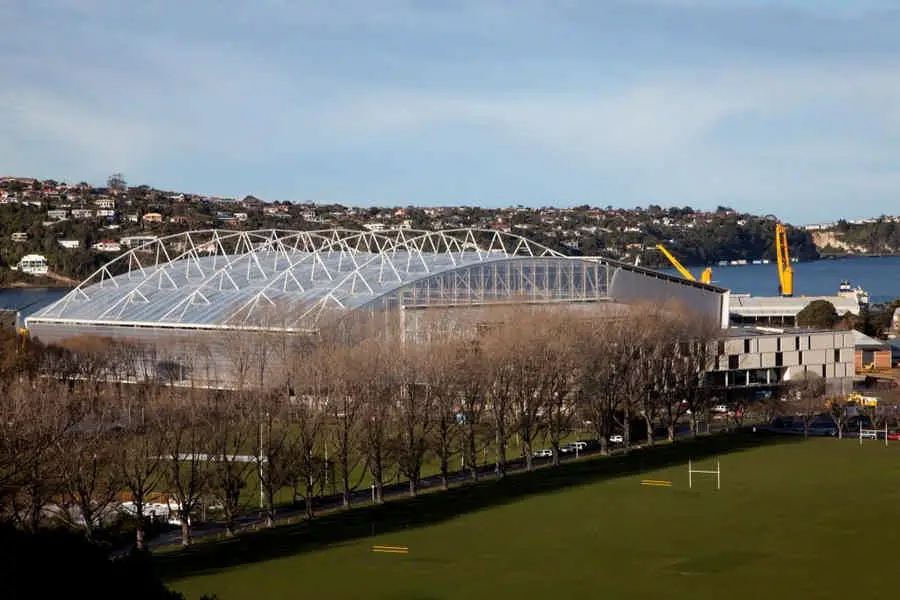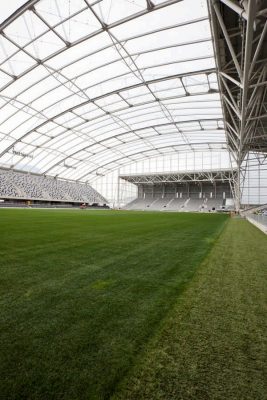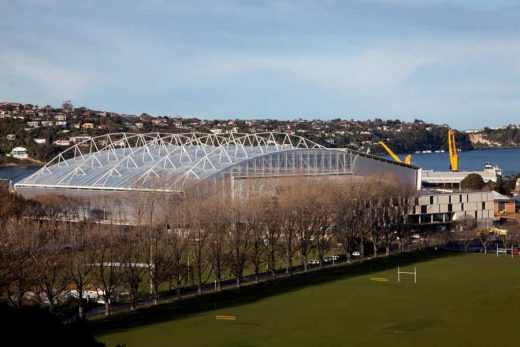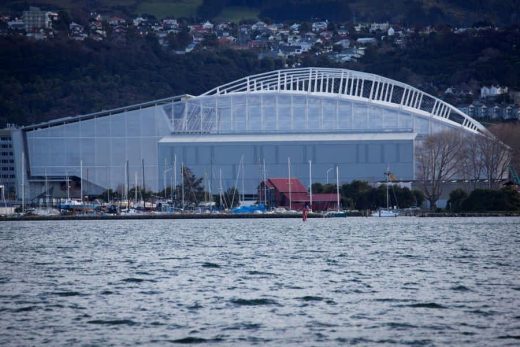Forsyth Barr Stadium Dunedin, New Zealand Buildings, 2011 Rugby World Cup Venue
Forsyth Barr Stadium, Dunedin
Rugby World Cup Venue New Zealand – design by Populous with Jasmax, architects
8 Sep 2011
Forsyth Barr Stadium Dunedin
New Zealand’s Revolutionary Forsyth Barr Stadium – A true hybrid – Ready for 2011 Rugby World Cup
Design: Populous with Jasmax
Forsyth Barr Stadium in Dunedin, New Zealand, is the world’s first permanently enclosed, natural turf stadium and is set to host four fixtures during the 2011 Rugby World Cup. Designed by international architecture and design practice Populous, and in association with the local firm Jasmax, the new stadium replaces the legendary Carisbrook House of Pain.
Photos: Marina Mathews, Populous
The Stadium is permanently enclosed by a unique, transparent roof which is the result of extensive research by the design team. While ETFE (ethylene tetrafluoroethylene) is not a new product and was originally developed for the space industry, it is the first time its UV translucent properties have been put to use in a stadium, creating the largest ETFE covered structure in the Southern Hemisphere.
Populous has also redesigned the stadium at Eden Park, increasing its capacity to 60,000 for the Rugby World Cup finals before reducing to 50,000 in its legacy mode. Eden Park will host the opening game of the tournament on Friday 9 September 2011.
Populous senior principal and project director of the Forsyth Barr stadium, Richard Breslin, said that an essential ingredient in stadium design is legacy. The revolutionary design of Forsyth Barr provides multifunctionality and flexibility so it is perfectly positioned to be used by its community all year round.
“New Zealanders are well known for their tenacity and innovation and that’s exactly what Forsyth Barr stadium is all about.
“Research by many people has created this final concept of a natural grass pitch growing under a permanent roof structure .The unique permanent roof is clad in EFTE, a transparent polymer or plastic, which is light, enclosed and translucent, allowing maximum sunlight onto the pitch, so that the grass keeps growing but the fans are protected from the elements and the action goes on whatever the weather.
“The permanent roof means Forsyth Barr is a true hybrid between a highly efficient, well functioning football/rugby stadium and an entertainment venue,” said Richard Breslin.
The stadium opens up the opportunities for the city of Dunedin. Not only does it now have the country’s largest rectangular stadium (as New Zealand’s other major stadia are all based around cricket and rugby), Forsyth Barr stadium will also be New Zealand’s largest indoor event venue, capable of hosting world class entertainment such as major concerts, performances and festivals. Its all round potential will be showcased by the singer songwriter Sir Elton John, who will stage the first concert at the stadium in November this year.
The rectangular design will also change the way we view the live game in New Zealand according to Richard Breslin.
“The angled seating pitch and enclosed roof will mean spectators are closer to the action than ever before and the atmosphere will be fantastic. I was there recently, and even though there was no game on, the sense of enclosure made the hairs stand up on the back of my neck. I could almost hear the noise, and the smell and feel of the atmosphere of the rival teams during that first big rugby match,” he said.
The stadium is located at the southern end of the South Island, and at latitude 42 degrees south, it is the most southerly professional stadium in the world. Dunedin’s extreme cold and wet climate makes the roof an essential feature to encourage crowds to attend live events.
A team of turf experts, engineers and the stadium architects undertook rigorous studies over two years to understand the effects of grass growth under ETFE all year round, and an ETFE test rig was built on site to monitor grass growth both under the rig and outside it.
Design Intent and Key Facts
• Forsyth Barr stadium is the world’s only permanently covered stadium to have a natural turf playing field. Construction began in June 2009 and was completed in August 2011.
• The key challenge for the design team was growing strong, healthy grass under a fixed roof. A team of turf experts, engineers and the stadium architects undertook rigorous studies over a two year period to understand the effects of grass growth under ETFE within the four seasons, and to ensure the pitch would be of a standard required for international sporting events.
• ETFE (ethylene tetrafluoroethylene) is a transparent polymer, originally developed for the space industry. The air filled two layer ETFE cladding has a light transparency of approximately 90% and has the unique quality of being UV transparent. It has been used to clad the stadium’s roof and facades. With 20,500 square metres of ETFE cladding, it is the largest ETFE covered structure in the Southern Hemisphere.
• ETFE is lighter than glass ( 1% of the weight) yet incredibly strong – able to bear 400 times its own weight and stretch to 3 times its length – which means it will handle the wind and snow of Dunedin’s cold southern climatic conditions.
• The design had to be created around parameters set by others. Following the two years of research, the stadium design was primarily dictated by the requirement to maximise sun strike levels and natural ventilation. The sectional profile of the stadium has been carefully designed to maximise the solar penetration onto the field as well as the natural ventilation of the playing surface.
• During the research and early design stages, an ETFE test rig was built on site to monitor grass growth both under the rig and outside it. Toward the end of the testing phase, it was discovered that the grass under the rig was stronger and healthier than the grass surrounding it, withstanding several high impact tests by local rugby.
• The innovative use of ETFE and the success of the grass growth sets a new benchmark for North American and Northern European venues for the feasibility of grass growth under an enclosed structure.
• The internal roof height is 37 metres.
• The stadium has been designed to function as New Zealand’s largest indoor arena as well as a sports stadium for rugby, rugby league and soccer.
• Stadium has 4 stands, 5 lounges and 21 corporate suites.
• As an arena, Forsyth Barr can hold 10,000 fans on the pitch plus seating in the stands.
• Stages can be set up either in the East stand or in front of the North Stand. The roof height means there is space for major theatrical productions requiring major rigging and stage structures.
• The stadium is master planned to create a truly urban stadium. The University of Otago is integrated into the western end of the ground, sharing a wall and some of the services and the NZ Academy of Sport will build their South Island headquarters at the northern side of the stadium.
About Populous
Populous is a global architecture, design practice and masterplanning consultancy that specialises in creating environments that draw people and communities together for unforgettable experiences. Over the past 30 years, the company has completed more than 1,000 projects around the globe with construction value exceeding US$20 billion. It has worked with 24 Major League Baseball franchises, 30 NFL franchises, 80 professional and civic arena clients, 40 soccer and rugby teams, 120 colleges and universities, 40 convention and performing arts centre clients, 29 equestrian clients and more than 30 major events.
Populous’ portfolio includes such icons as Yankee Stadium in New York; the London 2012 Olympic Stadium; Soccer City in South Africa, the Nanjing Sports Park in China, the Centre Court roof at Wimbledon, the new Lansdowne Road in Dublin and Sochi Olympic stadium in Russia for the 2014 Winter Olympics. In addition to its stadia designs, Populous has been involved in the development of the masterplans for the London 2012 Olympic Games, the Dubai Autodrome and the new Silverstone circuit, as well as working on overlay design for events including Super Bowls and the Olympic Games.
Populous has 500 employees in offices around the globe (Kansas City, London, Brisbane, Singapore, Hong Kong, New Delhi, Los Angeles, Auckland, Rio, Denver, Knoxville and New York) that enthusiastically embrace the expertise they uniquely claim—drawing people together around teams, athletes, events, places, commerce, industry and ideas they wholeheartedly embrace and adore.
Forsyth Barr Stadium images / information from Populous
Location: Dunedin, New Zealand
New Zealand Architecture
Contemporary New Zealand Buildings
New Zealand Architecture Designs – chronological list
New Zealand Architecture Studios
New Zealand Architecture Awards
Te Mata House, Hawkes Bay, North Island of New Zealand
Stevens Lawson Architects
Hawkes Bay House
Len Lye Centre, New Plymouth
Patterson Associates
Len Lye Centre
Auckland Architecture Awards – NZIA Awards 2010-11
The Michael Hill Clubhouse, Otago, South Island
Patterson Associates
Southern New Zealand Building
Comments / photos for Forsyth Barr Stadium Dunedin – New Zealand Rugby Venue page welcome




